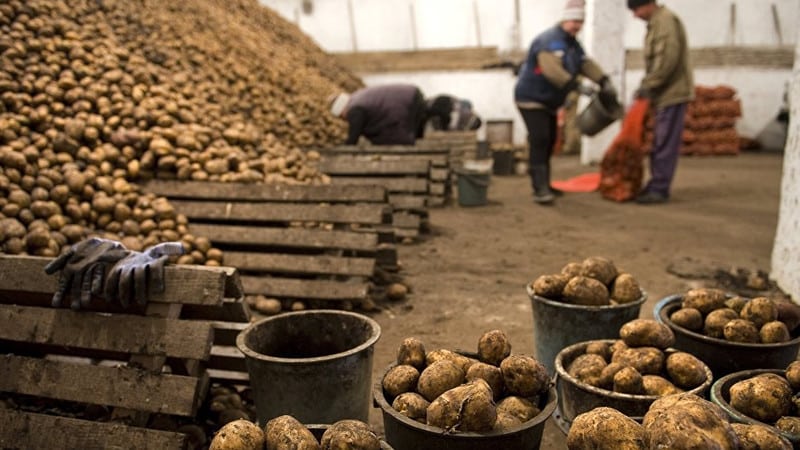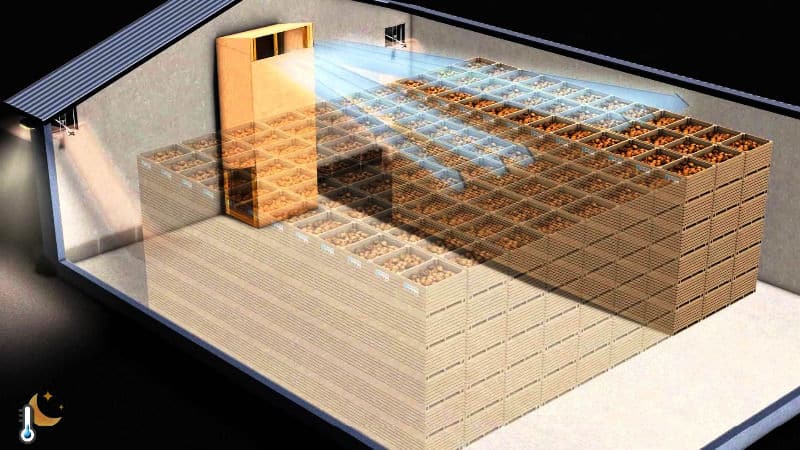The nuances of storing potatoes in a vegetable storehouse: how to create optimal conditions for the harvest
It is important not only to grow a good potato harvest, but also to provide it with proper storage. The demand for the product remains high throughout the year, so it is necessary that it does not lose its nutritional and taste qualities for as long as possible. To create suitable conditions for storing potatoes in a vegetable store, take into account temperature, characteristics of the vegetable variety, hidden diseases and other factors.
What should a vegetable storage facility be like for storing potatoes?

To store potatoes and other root crops, there are specialized buildings - vegetable warehouses, in which the crop is also processed and sorted. A rational and integrated approach reduces the percentage of losses even at the collection stage.
The storage of agricultural products, their quality and minimization of losses depend on how the storage facility was built and how adapted it is to perform its functions.
Modern technologies for the construction and operation of vegetable storage include:
- protection of the crop from the effects of natural phenomena (moisture and heat insulation of the building);
- safety of products from destruction by birds and rodents;
- the ability to constantly monitor the current state of vegetables;
- selection of optimal modes for certain zones;
- conditions for carrying out sorting, calibration procedures, as well as differential storage;
- comfortable stowage and shipment of products;
- carrying out measures to disinfect the premises.
At home, potato tubers are placed in storage facilities created underground or above ground for the winter. The first option is cellars with a depth of at least 2 m, equipped with a ventilation system and insulated so that the potatoes do not freeze.
The second option is above-ground storage facilities, arranged on the same principle as cellars. To maintain the required humidity and temperature, purchase a hygrometer and thermometer. It is especially important to monitor these parameters when the outside air temperature is below zero.
Preparing Potatoes

Preparations for storing potatoes begin even before harvesting: 7-10 days before the start of harvesting, they mow down the tops, on the foliage and stems of which harmful microorganisms live. During this time, the potatoes ripen in the ground, their skins become rougher, so the tubers are less damaged when dug up.
If the tops are not removed, during digging, microorganisms enter the tubers and then actively progress in the humid environment of the storage. The procedure reduces the risk of tuber infection with viral and fungal diseases.
Preliminary preparation before sending potatoes to the basement:
- The potatoes are scattered on the ground for several hours to dry in the sun. The tubers are stirred periodically so that ultraviolet rays destroy the causative agents of fungal and bacterial infections.
- Clean the vegetable from any remaining soil.
- They proceed to the next stage - sorting: large ones are selected for longer storage, medium ones - as planting material, small ones - for animal feed.
- Damaged and unsalable tubers are set aside.
- Those affected by scab, late blight, wireworm and other diseases are immediately disposed of away from the site.
- The selected product for storage is treated with any antifungal drug (Fitosporin, Baktofit or other similar biological agent) and dried in the shade for several days.
When the moisture leaves the surface of the peel, the potatoes are placed in boxes, nets or bags and sent to storage.
Creating optimal conditions
To store vegetables, it is important that there is no damage or disease on the tubers, that the temperature and humidity in the room are observed, and that the presence of oxygen is present. It is necessary to constantly monitor the parameters throughout the entire storage period.
Temperature
The optimal storage temperature for potatoes at any time of the year is +2…+3°C. Only at this temperature are the tubers at rest: not sprout and don't freeze. As the temperature rises, they begin to “wake up”: eyes appear, and then sprouts appear - the potatoes are preparing for spring planting. And solanine, a toxic substance, is formed in the peel and top layer.
If temperature will drop to –1°C, the potatoes will freeze and lose their taste. The prepared dish from it will have a sweetish taste, since at low temperatures the starch turns into sugar.
Attention! Frozen potatoes spoil quickly.
Humidity
It is necessary to create optimal air humidity. When the indicators remain at a level of 80 to 85%, the tubers do not dry out, which means there will be no weight loss during storage.
If you keep potatoes in too dry air, their taste will deteriorate, the tubers will become lethargic and lose their juiciness.If there is excessive humidity, there is a risk of rot and fungal diseases.
Ventilation
Good ventilation must be provided. It is advisable to use supply fans.
The floor of the vegetable storehouse cannot be covered with boards, linoleum or cemented - in such conditions the humidity increases and a favorable environment is created for the proliferation of fungal microorganisms. It is advisable to use bulk materials, for example, fine crushed stone or sand - they absorb excess moisture well.
Lighting
Exposing potatoes to direct sunlight will increase the concentration of solanine.
Important! Solanin in large quantities it is toxic and can lead to poisoning.
Many varieties of potatoes cannot be eaten if the tubers have been exposed to the sun for more than a day and a half.

Features of storing ware potatoes
Storage conditions should be selected according to the potato variety, but there are also general requirements for storing tubers intended for food. Keep the temperature within +1…+2°С. This reduces the likelihood of harmful bacteria developing.
A week before use or sale, the temperature is raised to room temperature. This will give the sugars time to decompose, resulting in the restoration of optimal taste.
Semennogo
If potatoes are stored for later planting, the temperature is kept at +6°C. In such conditions, the tubers will be able to germinate. If strong and long shoots appear, the tops will develop much faster.
Potato storage stages
Each stage must maintain its own temperature so that the potatoes do not spoil during storage.
Treatment stage
It begins immediately after harvest, when the tubers go through the process of ripening and healing all damage received during transportation and planting. During this period, the taste improves and the peel becomes stronger.
For storage you will need a ventilated room and dry air. The temperature is maintained at approximately +12°C for a month. If heating equipment is used, raise the temperature slowly to avoid condensation.
Temporary accommodation
Food crops require darkness, and seed crops require light. At this stage, all potato defects will appear. Bad tubers are discarded, the rest of the potatoes are inspected and prepared for the next stage.
Cooling

The purpose of the process is to prevent the germination and spread of infection and mold. Seed crops are cooled to +2°C, and table crops – to +5°C. The procedure is performed smoothly: the temperature is reduced by half a degree per day. If this recommendation is not followed, the flesh may darken.
Reference. According to GOST, the temperature should be within +2…+3°С. But if storage is expected for more than 3 months, then this indicator can be raised to +5...+7°C.
Methods for laying potatoes
Loading potatoes into a vegetable store affects the degree of possible damage.
There are 3 main technologies:
- in-line – cleaning, sorting, calibration (selection by size), as well as loading into the vegetable storage;
- transhipment – collection, storage of potatoes in temporary piles, sorting, calibration and unloading;
- direct flow – harvesting root crops and loading them into storage.
If the goods are not intended for sale in the fall, they are stored using the direct-flow method, and in extreme conditions - using the transshipment method.
The in-line technology of laying creates a large amount of mechanical damage, which leads to frequent darkening of the pulp. Because of this, there is 2 times more waste when peeling potatoes.
Shelf life
The shelf life depends on the starch contained in the potato. The process of its disintegration is inevitable, but the right conditions this happens later.
The average shelf life is 6-7 months. The maximum shelf life is 10 months, and the minimum can be one week (under unfavorable conditions).
The duration directly depends on the storage location. A vegetable storage facility is considered the most suitable option. There the potatoes remain edible for up to 10 months. But this requires good ventilation. If you use containers, different varieties can be stored in one place.
The most common method is to place the potatoes in the cellar. It is possible to create almost the same conditions as in a vegetable storehouse, that is, the tubers can last up to 10 months. Only tubers with thick skins are placed in the cellar.
Many people prefer to store potatoes on the balcony. In this case, the room must be insulated, otherwise the vegetables will freeze and lose their taste.
Conclusion
Potatoes are one of the staple products in any family. To reduce losses during storage and maintain high quality, it is necessary to properly prepare the tubers, take care of temperature, humidity and other factors affecting preservation.